Elevation 53 m | ||
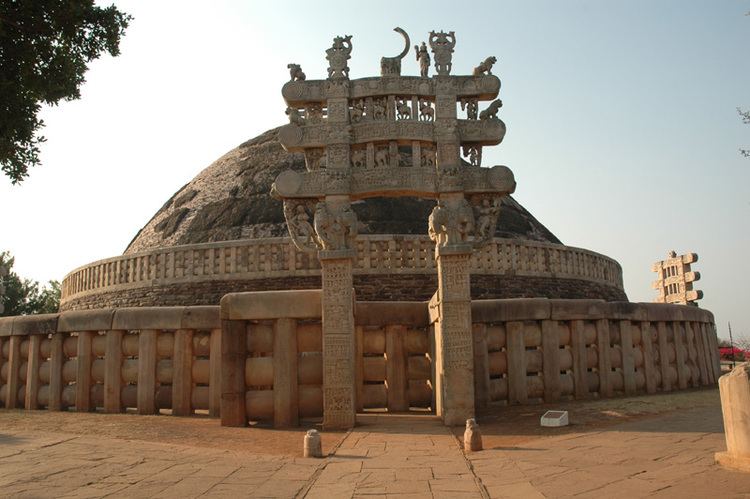 | ||
Weather 34°C, Wind NE at 5 km/h, 39% Humidity | ||
Chhota bheem aur krishna in pataliputra the city of the dead
Pataliputra (IAST: Pāṭaliputra), adjacent to modern-day Patna, was a city in ancient India, originally built by Magadha ruler Ajatashatru in 490 BCE as a small fort (Pāṭaligrāma) near the Ganges river.
Contents
- Chhota bheem aur krishna in pataliputra the city of the dead
- Pataliputra
- Etymology
- History
- Capital of the Maurya Empire
- Capital of later dynasties
- Structure
- Excavated sites of Pataliputra
- References
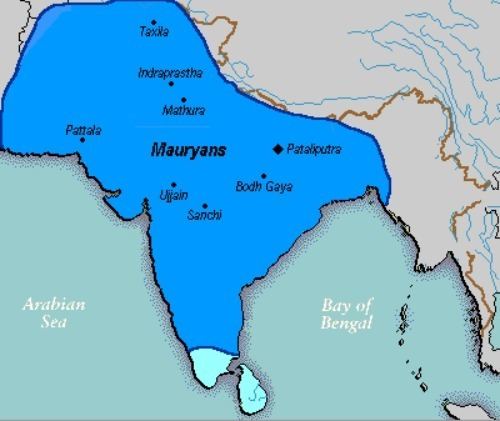
Extensive archaeological excavations have been made in the vicinity of modern Patna. Excavations early in the 20th century around Patna revealed clear evidence of large fortification walls, including reinforcing wooden trusses.
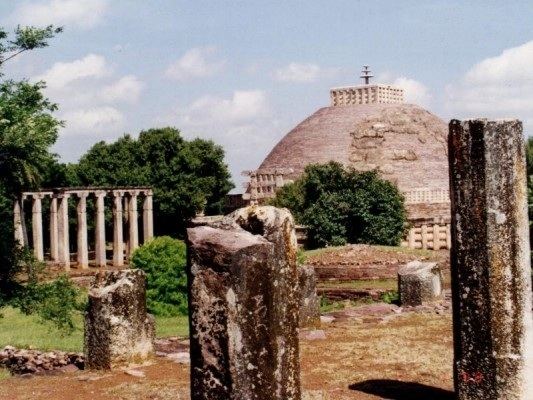
Pataliputra
Etymology
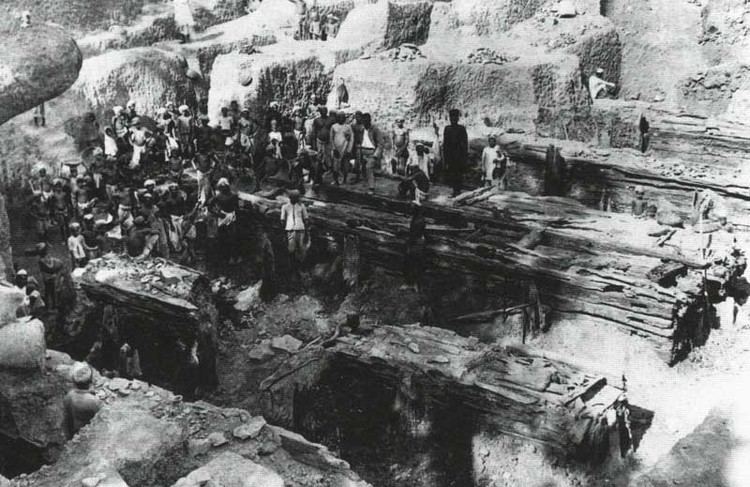
The etymology of Pataliputra is unclear. "Putra" means Son, and "pāţali" is a species of rice or the plant Bignonia suaveolens. One traditional etymology holds that the city was named after the plant. Another tradition says that Pāṭaliputra means the son of Pāṭali, who was the daughter of Raja Sudarshan. As it was known as Pāṭali-grāma ("Pāṭali village") originally, some scholars believe that Pāṭaliputra is a transformation of Pāṭalipura, "Pāṭali town".
History

There is no mention of Pataliputra in written sources prior to the early Buddhist texts (the Pali Canon and Āgamas), where it appears as the village of Pataligrama and is omitted from a list of major cities in the region. Early Buddhist sources report a city being built in the vicinity of the village towards the end of the Buddha's life; this generally agrees with archaeological evidence showing urban development occurring in the area no earlier than the 3rd or 4th Century BCE. In 303 BCE, Greek historian and ambassador Megasthenes mentioned Pataliputra as a city in his work Indika.
The city of Pataliputra was formed by fortification of a village by Haryanka ruler Bimbisara.
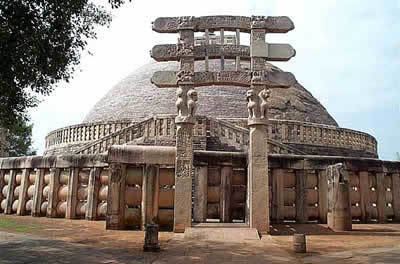
Its central location in north eastern India led rulers of successive dynasties to base their administrative capital here, from the Nandas, Mauryans, Shungas and the Guptas down to the Palas. Situated at the confluence of the Ganges, Gandhaka and Son rivers, Pataliputra formed a "water fort, or jaldurga". Its position helped it dominate the riverine trade of the Indo-Gangetic plains during Magadha's early imperial period. It was a great centre of trade and commerce and attracted merchants and intellectuals, such as the famed Chanakya, from all over India.

Two important early Buddhist councils are recorded in early Buddhist texts as being held here, the First Buddhist council immediately following the death of the Buddha and the Second Buddhist council in the reign of Ashoka. Jain and Brahmanical sources identify Udayabhadra, son of Ajatashatru, as the king who first established Pataliputra as the capital of Magadha.
Capital of the Maurya Empire
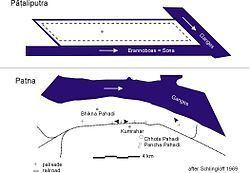
During the reign of Emperor Ashoka in the 3rd century BCE, it was one of the world's largest cities, with a population of 150,000–400,000. The city is estimated to have had a surface of 25.5 square kilometers, and a circumference of 33.8 kilometers, and was in the shape of a parallelogram and had 64 gates (that is, approximately one gate every 500 meters). Pataliputra reached the pinnacle of prosperity when it was the capital of the great Mauryan Emperors, Chandragupta Maurya and Ashoka. The city prospered under the Mauryas and a Greek ambassador, Megasthenes, resided there and left a detailed account of its splendour, referring to it as "Palibothra":
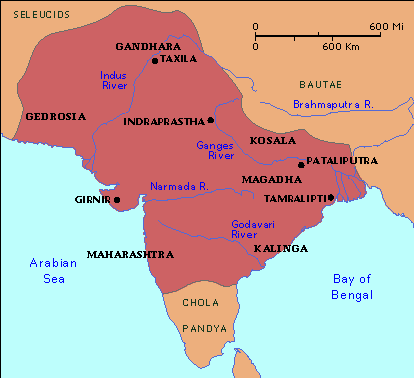
"Megasthenes says that on one side where it is longest this city extends ten miles in length, and that its breadth is one and threequarters miles; that the city has been surrounded with a ditch in breadth 600 feet, and in depth 45 feet; and that its wall has 570 towers and 64 gates." Arrian, "The Indica"
Strabo in his Geographia adds that the city walls were made of wood. These are thought to be the wooden palisades identified during the excavation of Patna.
"At the confluence of the Ganges and of another river is situated Palibothra, in length 80, and in breadth 15 stadia. It is in the shape of a parallelogram, surrounded by a wooden wall pierced with openings through which arrows may be discharged. In front is a ditch, which serves the purpose of defence and of a sewer for the city." Strabo, "Geographia"
Aelian, although not expressly quoting Megasthenes nor mentionning Pataliputra, described Indian palaces as superior in splendor to Persia's Susa or Ectabana:
"In the royal residences in India where the greatest of the kings of that country live, there are so many objects for admiration that neither Memnon's city of Susa with all its extravagance, nor the magnificence of Ectabana is to be compared with them. (...) In the parks, tame peacocks and pheasants are kept." Aelian, "Characteristics of animals"
Ashoka's Palace in Pataliputra and the monument columns everywhere in India were built to imitate the Achaemenid palaces and Persepolis columns. The architecture of Pataliputra's enclosures and the monumental columns of Ashoka had been affected by Persian Achaemenid architecture. The design of the Pataliputra palace capital has been described as Perso-Iionic, with a strong late-archaic Greek stylistic influence, including volute, bead and reel, meander or honeysuckle designs.
Capital of later dynasties
The city also became a flourishing Buddhist centre boasting a number of important monasteries. It remained the capital of the Gupta dynasty (3rd–6th centuries) and the Pala Dynasty (8th-12th centuries). The city was largely in ruins when visited by Xuanzang, and suffered further damage at the hands of Muslim raiders in the 12th century. Afterwards, Sher Shah Suri made Pataliputra his capital and changed the name to modern Patna.
Structure
Though parts of the ancient city have been excavated, much of it still lies buried beneath modern Patna. Various locations have been excavated, including Kumhrar, and Bulandi Bagh.
During the Mauryan period, the city was described as being shaped as parallelogram, approximately 1.5 miles wide and 9 miles long. Its wooden walls were pierced by 64 gates. Archaeological research has found remaining portions of the wooden palisade over several kilometers, but stone fortifications have not been found.
